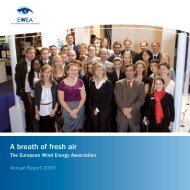Offshore Electricity Infrastructure in Europe - European Wind Energy ...
Offshore Electricity Infrastructure in Europe - European Wind Energy ...
Offshore Electricity Infrastructure in Europe - European Wind Energy ...
You also want an ePaper? Increase the reach of your titles
YUMPU automatically turns print PDFs into web optimized ePapers that Google loves.
FIGURE 5.2: OvERvIEW ON OFFShORE WINd SUPPORT SchEMES ANd GRId cONNEcTION<br />
h<strong>in</strong>ders for <strong>in</strong>stance the <strong>in</strong>stallation of w<strong>in</strong>d farms<br />
outside national territories of one country while connect<strong>in</strong>g<br />
it to this country. International agreement and<br />
consolidation on this issue is greatly needed.<br />
It should be mentioned that besides the <strong>in</strong>compatibility<br />
of support schemes, also unaligned national<br />
offshore w<strong>in</strong>d energy development goals can hamper<br />
the development of an offshore grid. This is because<br />
strategic cross-border coord<strong>in</strong>ation with compatible<br />
offshore goals, sit<strong>in</strong>g and tim<strong>in</strong>g can strongly support<br />
the offshore grid development with offshore w<strong>in</strong>d farm<br />
clusters as major nodes.<br />
Permitt<strong>in</strong>g<br />
The permitt<strong>in</strong>g processes for offshore w<strong>in</strong>d farms and<br />
their connection to onshore land<strong>in</strong>g po<strong>in</strong>ts differ widely<br />
across countries. This represents a medium barrier<br />
from the po<strong>in</strong>t of view of the <strong>Offshore</strong>Grid consortium.<br />
There is a wide variety <strong>in</strong> the number of national executive<br />
authorities <strong>in</strong>volved <strong>in</strong> each country, and not<br />
all countries carry out maritime spatial plann<strong>in</strong>g. This<br />
causes the national permitt<strong>in</strong>g processes to differ <strong>in</strong><br />
level of detail, duration and costs, and they are largely<br />
unsynchronised between authorities.<br />
<strong>Offshore</strong>Grid – F<strong>in</strong>al Report<br />
In most countries however the grid connection responsibility<br />
lies with the national TSO who is obliged to<br />
provide connection to offshore w<strong>in</strong>d farms. This facilitates<br />
a coord<strong>in</strong>ated jo<strong>in</strong>t action among the responsible<br />
TSOs which can for <strong>in</strong>stance be led by ENTSO-E.<br />
Operational responsibilities and offshore<br />
grid codes<br />
The clear allocation of operational responsibilities between<br />
national TSOs is seen as a medium barrier for<br />
an <strong>in</strong>ternational offshore grid. Also, the harmonisation<br />
of offshore grid codes used represents a challenge.<br />
The possibility of sett<strong>in</strong>g up an <strong>in</strong>ternationally owned<br />
and operated offshore TSO is currently discussed<br />
[46]. The development of <strong>Europe</strong>an network codes as<br />
<strong>in</strong>itiated by the <strong>Europe</strong>an Commission is a first step<br />
towards overcom<strong>in</strong>g this challenge. For <strong>in</strong>stance the<br />
grid code on the connection requirements for offshore<br />
w<strong>in</strong>d turb<strong>in</strong>es across <strong>Europe</strong> is planned to enter <strong>in</strong>to<br />
force <strong>in</strong> 2011/2012. Additional network codes, for example<br />
codes for the grid operation or a network code<br />
on electricity markets may further enhance the coord<strong>in</strong>ated<br />
plann<strong>in</strong>g of an offshore grid as well as its save<br />
operation.<br />
85









